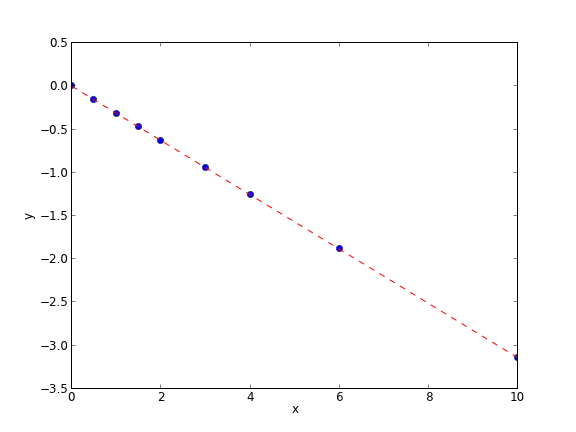Linear least squares fitting with linear algebra
Posted February 18, 2013 at 09:00 AM | categories: data analysis, linear algebra | tags:
Updated February 27, 2013 at 02:38 PM
The idea here is to formulate a set of linear equations that is easy to solve. We can express the equations in terms of our unknown fitting parameters \(p_i\) as:
x1^0*p0 + x1*p1 = y1 x2^0*p0 + x2*p1 = y2 x3^0*p0 + x3*p1 = y3 etc...
Which we write in matrix form as \(A p = y\) where \(A\) is a matrix of column vectors, e.g. [1, x_i]. \(A\) is not a square matrix, so we cannot solve it as written. Instead, we form \(A^T A p = A^T y\) and solve that set of equations.
import numpy as np x = np.array([0, 0.5, 1, 1.5, 2.0, 3.0, 4.0, 6.0, 10]) y = np.array([0, -0.157, -0.315, -0.472, -0.629, -0.942, -1.255, -1.884, -3.147]) A = np.column_stack([x**0, x]) M = np.dot(A.T, A) b = np.dot(A.T, y) i1, slope1 = np.dot(np.linalg.inv(M), b) i2, slope2 = np.linalg.solve(M, b) # an alternative approach. print i1, slope1 print i2, slope2 # plot data and fit import matplotlib.pyplot as plt plt.plot(x, y, 'bo') plt.plot(x, np.dot(A, [i1, slope1]), 'r--') plt.xlabel('x') plt.ylabel('y') plt.savefig('images/la-line-fit.png')
0.00062457337884 -0.3145221843 0.00062457337884 -0.3145221843

This method can be readily extended to fitting any polynomial model, or other linear model that is fit in a least squares sense. This method does not provide confidence intervals.
Copyright (C) 2013 by John Kitchin. See the License for information about copying.